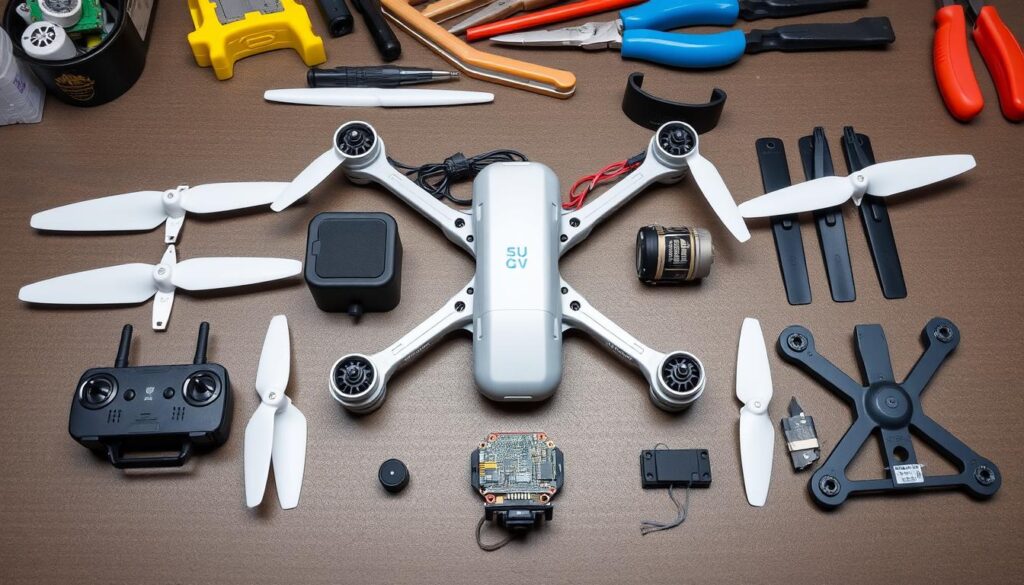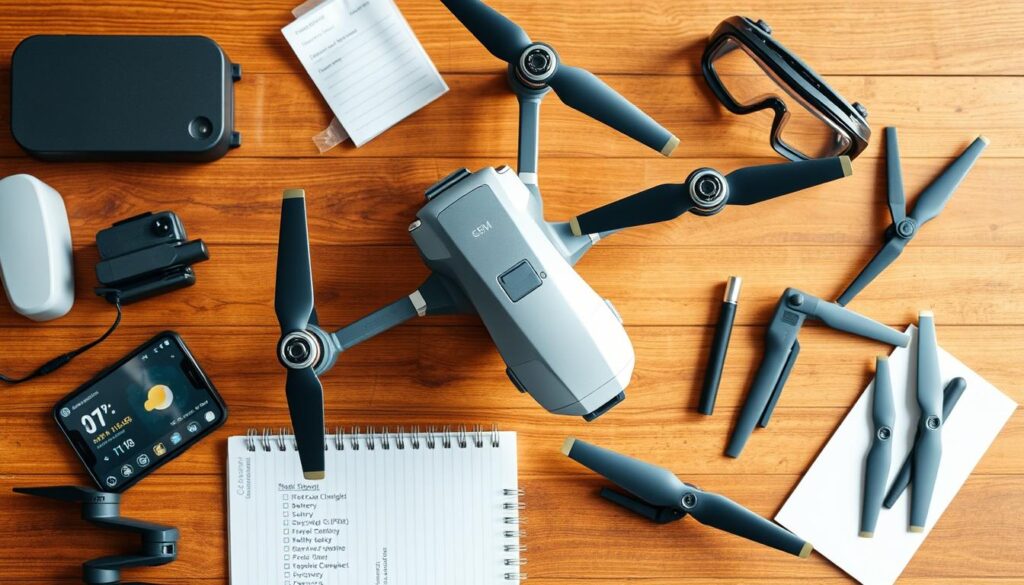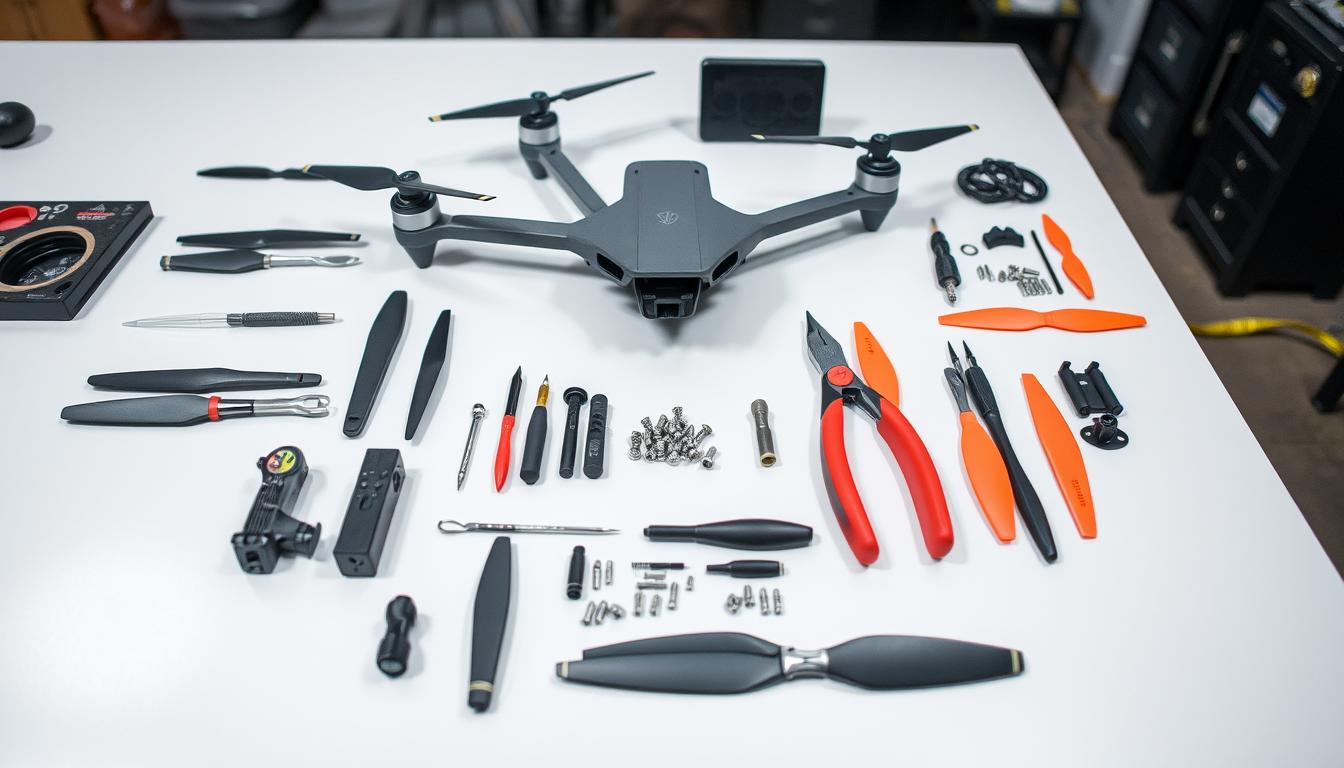As drone fans, we know how vital it is to keep our UAVs in perfect shape. A top-notch drone maintenance kit is key for the best performance and safety. Our kit should have all the tools and supplies needed for regular upkeep and quick fixes.
First off, our kit must have a full set of screwdrivers and hex keys. These are crucial for getting into and tightening our UAV’s parts, like propellers and motors. Having different sizes and types of these tools means we’re ready for any fastener we might find.
Cleaning tools and brushes are also a must. Keeping our drones clean prevents dirt and dust from affecting their performance. Soft-bristled brushes, microfiber cloths, and special cleaning solutions for electronics are perfect for keeping our drones spotless.
For more complex repairs, we need soldering tools and a multimeter. Soldering lets us fix or replace damaged wiring. A multimeter helps us find electrical problems and check if our UAV’s parts are working right.
Finally, having spare parts and replacement components is wise. Replacing propellers is common, so having extras saves us time. Also, having extra motors, batteries, and other key parts ready helps us fix issues fast.
Key Takeaways
- A well-stocked drone maintenance kit is essential for keeping our UAVs in top condition.
- Screwdriver sets and hex key sets are crucial for accessing and tightening various drone components.
- Cleaning supplies and brushes help prevent the buildup of dirt and debris, ensuring optimal performance.
- Soldering tools and a multimeter are valuable for advanced repairs and diagnosing electrical issues.
- Keeping spare parts and replacement components on hand, such as propellers and motors, can minimize downtime during maintenance or repairs.
Understanding Drone Components and Their Functions
To keep our drones in top shape, it’s key to know the drone components and their roles. Learning about these parts helps us maintain our drones well. It also helps us fix any problems that come up.

Propellers and Motors
Propellers and motors work together to lift and move our drones. Most drones have two standard propellers and two reverse ones for balance. The motors, often brushless motors, spin the propellers.
Brushless motors are more efficient (85-90%) than brushed motors (75-80%).
When picking motors, look at their size and specs:
- Larger motors make more thrust but are heavier
- Taller stators in motors offer high speeds but poor low-speed handling
- Wider stators in motors give better low-speed handling but lower top speeds
- KV rating shows the motor’s RPM per volt without a load
For example, a 2207 motor is 22mm wide and 7mm tall. A 2300KV motor with a 4S battery can hit 34,040 RPM without propellers.
Flight Controller and GPS Module
The flight controller is our drone’s brain, controlling motor speeds and navigation. It works with the GPS module for stable and accurate flight. Modern flight controllers have cool features like obstacle avoidance and self-flight modes.
Battery and Power Management
Good battery care is vital for safe drone use. Li-po batteries are common for drones because of their performance and flight time. It’s important to check battery health and performance often to keep our drones running well and safe.
| Drone Type | Specific Components |
|---|---|
| Racing Drones | More moving parts for easier repairs after crashes, including motor mounts, independent arms, and motor control units |
| Agricultural Drones | Multispectral cameras to detect pests, diseases, and water stress in crops |
Knowing these key drone components and their roles helps us keep our drones in great shape. This ensures they work their best.
Implementing Pre-Flight and Post-Flight Checklists
To keep our drones safe and in good shape, we need to follow pre-flight and post-flight checklists. These checklists help us spot problems early and keep our drones running well. The Federal Aviation Administration (FAA) says drone pilots must do pre-flight checks to make sure everything is ready for flying.
Before we fly, we should check the drone’s parts for damage or wear:
- Frame
- Motors
- Propellers
- Battery
- Camera
- Gimbal
We also need to make sure the drone’s battery is charged, the camera works, and we have enough memory. Keeping the drone’s software up to date is key for following rules and flying well. Pre-flight checklists help us find problems and avoid risks.

After flying, we must do a detailed post-flight inspection. This means cleaning the drone, checking for any damage, and updating maintenance logs. If a pre-flight check finds damage, we can use special checklists to fix the drone.
“Post-flight checklists can assist in clearing out debris, identifying damage, and directing equipment maintenance or repairs.” – Fluix
Digital checklists, like those from Fluix, make it easy to do pre-flight and post-flight checks on phones or mobile devices. This makes it simpler to report any damage or issues, helping to keep everyone safe.
| Checklist Type | Purpose | Key Components |
|---|---|---|
| Pre-Flight | Ensure drone safety and compliance | Drone inspection, flight plans, flying conditions, pilot documentation |
| Post-Flight | Identify issues and maintenance needs | Cleaning, component inspection, maintenance log updates |
By sticking to these checklists, we can fly our drones safely and follow FAA rules. This careful approach to drone safety and upkeep will help our drones last longer and perform better, reducing the chance of accidents or rule-breaking.
Developing a Routine Drone Maintenance Strategy
Creating a regular maintenance plan for your drone is key to keeping it running well. By regularly cleaning and checking your drone, you can avoid expensive repairs and keep it flying smoothly. A well-kept drone is safer and more reliable.
Proper care can make your drone last longer. Always check your drone before flying and charge the battery fully. Also, keep your drone’s software up to date for better performance and new features.
Cleaning and Inspecting the Drone
Start by cleaning your drone’s frame, motors, and parts. Remove dirt and dust that builds up during flights. Focus on the propellers and motors, as they get dirty easily. Cleaning keeps your drone looking good and running well.
Checking and Tightening Screws and Fastenings
Screws and fasteners can loosen over time. Check and tighten them regularly. This keeps your drone stable and prevents parts from falling off during flight. Use the right tools and avoid over-tightening to avoid damage.
Examining Motors and Propellers
Motors and propellers are vital for your drone’s performance. Check them for wear or damage during maintenance. Look for cracks or chips on propellers and make sure they’re attached right. Replace any damaged parts to keep your drone safe and efficient.
| Maintenance Task | Frequency | Benefits |
|---|---|---|
| Cleaning and inspecting the drone | After every flight | Prevents buildup, ensures efficient cooling and smooth operation |
| Checking and tightening screws and fastenings | Every 10-15 flights | Maintains structural integrity, prevents components from loosening |
| Examining motors and propellers | Every 20-30 flights | Identifies wear and damage, ensures optimal performance |
Maintaining Landing Gear and Camera
Don’t forget to care for your drone’s landing gear and camera. Check the landing gear for damage and ensure it works right. Clean the camera lens often for better pictures. If your drone has a gimbal, check it for looseness and follow the maker’s care tips.
Regular maintenance is the key to keeping your drone in top shape and ensuring a safe and enjoyable flying experience.
By sticking to a maintenance plan, you can avoid accidents, extend your drone’s life, and enjoy its many benefits.
Essential Tools and Supplies for Drone Maintenance
To keep your drone in top shape, you need the right tools and supplies. A good drone repair kit saves time and money. Let’s look at some key items every drone lover should have.
Screwdriver Sets and Hex Key Sets
Screwdriver sets and hex key sets are key for drone upkeep. They help you tighten and adjust parts, keeping your drone stable. Get a quality set with various sizes for different screws in your drone.
Cleaning Supplies and Brushes
Cleaning your drone is vital for its performance and life. Use cleaning brushes, microfiber cloths, and compressed air. These tools remove dirt and debris from motors and propellers. Regular cleaning stops buildup that can harm your drone.
Soldering Tools and Multimeter
For complex repairs, soldering tools and a multimeter are essential. A soldering iron fixes wires and connections. A multimeter checks electrical issues. These tools prevent small problems from becoming big ones.
Spare Parts and Replacement Components
Accidents can still happen, even with good care. Keep spare propellers, motors, and parts in your kit. Having these ready quickly reduces downtime. Make sure the parts fit your drone’s model.
| Maintenance Task | Frequency |
|---|---|
| Routine inspections (frame, motors, propellers, battery, camera, gimbal) | Before each flight |
| Comprehensive maintenance | Every 10-20 flight hours |
| In-depth maintenance and component replacement | Every 50-100 flight hours |
Investing in the right tools and supplies helps your drone fly smoothly. Follow the manufacturer’s advice and maintain your drone regularly. This keeps it running well for a long time.
Basic Drone Repair Techniques
Learning basic drone repair is key for drone lovers. Doing simple repairs yourself saves time and money. It also keeps your drone in top shape. Here, we’ll cover essential repair skills for drone owners.
Before starting any repairs, check your drone’s manual. Always turn off your drone and remove the battery first. This is for safety.
Propeller Replacement
Propellers often get damaged and are easy to replace. This quick fix can be done in minutes. Make sure the new propellers are well attached and balanced for best flight.
- Remove the damaged propeller by unscrewing it counterclockwise.
- Clean the motor shaft and ensure it’s free of debris.
- Attach the new propeller, tightening it clockwise until secure.
- Repeat the process for any other damaged propellers.
Motor Replacement
Even tough motors can wear out after flying a bit. If your drone’s motors sound odd or don’t work right, it’s time for a new one. Here’s how to replace them:
- Remove the damaged motor by unscrewing it from the frame.
- Disconnect the motor wires from the electronic speed controller (ESC).
- Connect the new motor’s wires to the ESC, ensuring the correct polarity.
- Secure the new motor to the frame using the appropriate screws.
Soldering and Wiring Repairs
Electrical problems might need soldering and wiring fixes. Knowing these basics is crucial for your drone’s electrical health. Here are some tips for soldering repairs:
- Use a high-quality soldering iron and solder made for electronics.
- Ensure the wires are clean and free of debris before soldering.
- Apply heat shrink tubing to protect the soldered connections.
- Double-check your work to ensure secure and reliable connections.
| Repair Technique | Tools Required | Difficulty Level |
|---|---|---|
| Propeller Replacement | Screwdriver | Easy |
| Motor Replacement | Screwdriver, Soldering Iron | Moderate |
| Soldering and Wiring Repairs | Soldering Iron, Solder, Heat Shrink Tubing | Moderate to Difficult |
Mastering these drone repair basics helps you fix common problems. Regular upkeep and quick fixes keep your drone flying well. This also makes it safer and more efficient.
Troubleshooting Common Drone Issues
Even with regular maintenance, you may still face issues with your drone. It’s important to know how to fix these problems quickly. This way, you can avoid downtime and keep your drone in great shape. Common problems include power issues, GPS signal loss, unstable flight, and poor image quality.
For power issues, first check the battery. Make sure it’s fully charged and connected right. If it’s not the problem, look at the wiring and connectors for damage or loose connections. Faulty motors or ESCs can also cause power problems, so they might need to be replaced or fixed by a pro.
GPS signal loss can make your drone hard to control. Start by checking if the GPS module is connected right and not blocked. Look for interference from things like power lines or metal. If it’s still a problem, try recalibrating the GPS or updating the drone’s software.
Unstable flight can happen for many reasons. Check the propellers for damage and replace them if needed. Look at the motors for debris or wear and clean or replace them if necessary. If it’s still a problem, recalibrate the drone’s compass and accelerometer.
“By familiarizing yourself with these issues and their potential solutions, you can quickly diagnose and address them, minimizing downtime and ensuring your drone remains in top condition.”
Lastly, poor image quality can be a big problem for those who love aerial photos and videos. Start by cleaning the camera lens and making sure it’s not blocked. Check the camera settings to see if they’re right for the light. If it’s still bad, try updating the camera’s software or replacing the camera module.
Knowing how to fix these common drone problems can help you avoid accidents. It ensures your drone is always ready for its next adventure.
Battery Care and Maintenance
Proper battery care and maintenance are key for your drone’s long life and safety. Follow best practices for charging, storing, and monitoring. This way, you can get the most out of your drone and avoid accidents.
Proper Charging and Storage Practices
Always use the charger recommended by the battery maker when charging LiPo batteries. Store your batteries at about 50% charge in a cool, dry spot. This helps keep your drone running well for longer.
Here are some key tips for proper battery care:
- Remove the battery after flying and let it cool down
- Avoid overcharging the battery
- Store batteries in a cool, dry place
- Charge batteries to around 50% for long-term storage
Monitoring Battery Health and Performance
It’s important to check your battery’s health and performance often. Look for swelling, damage, or if it’s not holding charge as well. Replace batteries when needed to keep your drone flying smoothly.
| Battery Health Indicator | Ideal Range | Action Required |
|---|---|---|
| Voltage | 3.7V – 4.2V per cell | Recharge or replace if consistently low |
| Capacity | 80% – 100% of original capacity | Replace if capacity drops below 80% |
| Physical Condition | No swelling, cracks, or damage | Replace immediately if any damage is observed |
By focusing on drone battery maintenance, charging LiPo batteries right, and keeping them stored well, you can make your drone last longer. Enjoy safe and reliable flights by keeping up with monitoring battery health.
Software Updates and Calibration
It’s important to keep your drone’s software and firmware up to date. This ensures your drone works well and safely. Manufacturers often release updates with bug fixes and new features.
Calibrating your drone’s sensors and parts is also key. This includes compass and IMU calibration. These steps help your drone fly smoothly and accurately.
Updating Firmware and Software
Updating your drone’s firmware and software is crucial. It keeps your drone running smoothly and securely. Regular updates add new features and fix issues.
Performing Compass and IMU Calibrations
Compass calibration is vital for your drone’s navigation. You’ll need to rotate your drone in specific ways. This ensures your drone knows its direction and flies steadily.
IMU calibration is also important. Place your drone on a flat surface and let it settle. This helps your drone measure its movements accurately. This leads to better control and smoother flight.
By updating your drone’s software and calibrating it regularly, you’ll enjoy better performance. This makes flying safer and more fun.
Building a Comprehensive Drone Maintenance Kit
As drone enthusiasts, we know that having a well-stocked and organized drone maintenance kit is key. It keeps our aerial vehicles in top shape. A sturdy carrying case is a must for protecting and moving your tools and spare parts.
A battery tester and prop balancer are also crucial. They help spot and fix issues before they get worse.
Spare parts are a must-have in any drone maintenance kit. Having extra propellers, motors, and parts saves time and hassle. A good soldering iron, like the Sequre SQ-D608B or Aoyue soldering station, is also important. They offer great performance at a fair price.
For quick repairs, the portable TS100 soldering iron is perfect. The Hakko FX888D is great for hobbyists who want digital temperature control and preset options.
Organizing your repair tools and spare parts is vital. Use a modular storage system or a dedicated tool organizer. Labeling your containers helps you find what you need fast. A well-organized maintenance kit means you’re ready for any drone issue, keeping your vehicle in top shape for future flights.
